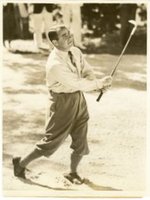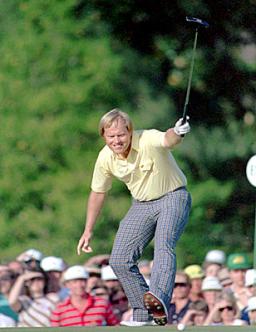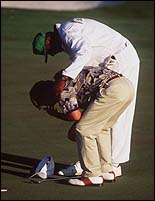 Welcome to a new column here at The Sand Trap .com. Every Tuesday, the “Trap Five,” an admittedly non-clever play on words (“top five”) will count down the top five… whatevers! One week we’ll have the top five swings in golf, and the next week we may have the top five hottest player’s wives.
Welcome to a new column here at The Sand Trap .com. Every Tuesday, the “Trap Five,” an admittedly non-clever play on words (“top five”) will count down the top five… whatevers! One week we’ll have the top five swings in golf, and the next week we may have the top five hottest player’s wives.
We’re starting it off in style as we count down the “Most Memorable Masters Moments.” Our criteria vary, and any list is up for debate. You won’t find Phil Mickelson’s victory last year here, nor will you find Faldo’s in 1996 over Greg Norman. Larry Mize’s chip-in didn’t make the list, and Mike Weir’s victory was pretty ho-hum. Roberto de Vicenzo is missing, as are a whole host of others. Who did make the cut? Find out…
Number Five: Gene Sarazen in 1935
Sarazen hit “The shot heard ’round the world” in the 1935 Masters. It was a final round 225-yard 4-wood on the par-5 15th hole that went in, giving him a very rare double eagle 2 on the hole. It led to him later winning the tournament in a playoff. Gene Sarazen went on to beat Craig Wood by five strokes in a 36-hole Monday playoff. This was the second Masters, and the first in which the nines were played in their current order. Though many like to believe that Gene’s double eagle put The Masters on the map, the tournament did not really gain success until several years later.
Number Four: Tiger Woods in 1997
Tiger Woods began his remarkable run in golf by becoming the youngest winner in the history of The Masters. His four-day total of 18-under-par broke the previous scoring record of 17-under shared by Jack Nicklaus and Raymond Floyd. His 12-shot win over Tom Kite is also the largest margin of victory since the event began. His fist pump on the last hole has been seen by one and all, and this victory merely provided a glimpse of what was to come from Mr. Woods.
Number Three: Jack Nicklaus in 1986
 Prior to Tiger’s victory in 1997, Jack Nicklaus held the record as the youngest Masters winner at the age of 23. His victory in 1986 earned Jack a spot at the other end of the record as the oldest victor. Jack’s stunning win was his sixth – another record – that was as much his victory as others’ losses: Seve Ballesteros found a watery grave at the par-5 15th. Tom Kite couldn’t hole a short birdie putt. Greg Norman pushed his second shot at 18 well to the right and into the crowd. Nicklaus, however, led a charge after starting the day four strokes back of Norman. But don’t take our word for it, check it out in the words of the players.
Prior to Tiger’s victory in 1997, Jack Nicklaus held the record as the youngest Masters winner at the age of 23. His victory in 1986 earned Jack a spot at the other end of the record as the oldest victor. Jack’s stunning win was his sixth – another record – that was as much his victory as others’ losses: Seve Ballesteros found a watery grave at the par-5 15th. Tom Kite couldn’t hole a short birdie putt. Greg Norman pushed his second shot at 18 well to the right and into the crowd. Nicklaus, however, led a charge after starting the day four strokes back of Norman. But don’t take our word for it, check it out in the words of the players.
Number Two: Arnold Palmer in 1958
Before 1958, there was no Amen Corner. Sure, the 11th, 12th, and 13th holes were there at Augusta, just as they had been since 1935. But they weren’t called Amen Corner until, in looking to describe Arnold Palmer’s miraculous victory, writer Herbert Warren Wind coined the phrase to describe where the critical action took place on the course that day. The famous pants-hitcher had no trouble sliding into his first green jacket, and he slipped into three more in alternating years (1960, 1962, 1964). Arnold Palmer, many said, was made for Augusta National, and the course for him. Arnold’s victory remains one of the most popular and thrust Augusta National, The Masters, and Palmer himself into the spotlight.
Number One: Ben Crenshaw in 1995
 Legendary teacher Harvey Penick passed away, and 1984 Masters champion Ben Crenshaw couldn’t have been more saddened. Crenshaw played his way around Augusta National in a bit of a daze, and broke through on the last green shortly before breaking down in tears. His game was not in good shape heading into the tournament, and Crenshaw credited Penick as “the 15th club in the bag” that week. For a few days in 1995, The Masters became the greatest celebration of golf the world has ever seen – its players, its teachers, its traditions. Crenshaw may have been the beneficiary of many “Harvey bounces” that week at Augusta, but every golfer was a beneficiary of his victory.
Legendary teacher Harvey Penick passed away, and 1984 Masters champion Ben Crenshaw couldn’t have been more saddened. Crenshaw played his way around Augusta National in a bit of a daze, and broke through on the last green shortly before breaking down in tears. His game was not in good shape heading into the tournament, and Crenshaw credited Penick as “the 15th club in the bag” that week. For a few days in 1995, The Masters became the greatest celebration of golf the world has ever seen – its players, its teachers, its traditions. Crenshaw may have been the beneficiary of many “Harvey bounces” that week at Augusta, but every golfer was a beneficiary of his victory.
Photo Credit: © Augusta.com, GolfWeb.
